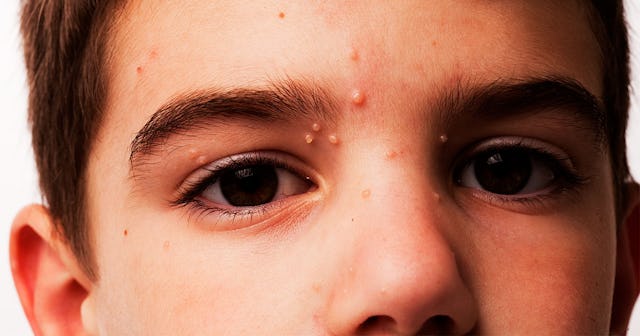Molluscum Is The Childhood Rash We All Dread — But It's Going To Be OK...Eventually

I recognized it right away when a parent in one of my social media groups posted a close-up of their child’s skin. The pink, raised bumps were shiny, and the child’s parent noted that the bumps seemed to have multiplied overnight. The commenters played a familiar round of name-that-rash, some suspecting chicken pox, eczema, and contact dermatitis. One mom (always) asked if the child had recently been vaccinated. Another one asked if the child had tried any new foods the day before.
But I knew the truth. The child had molluscum, and I commented, sorrowfully, letting the parent know my unofficial medical opinion. All four of my kids have had this dreaded, highly-contagious, aggressive skin issue in the past. Molluscum isn’t the end of the world, but it can take weeks or even months (up to a freaking year!) to clear up, and meanwhile, the kids pass it to each other. Cue David Rose saying, “Ew.”
Thankfully, Scary Mommy was able to get in touch with a dermatologist to help us with all our burning molluscum questions. More so, we got you the answers you need so you’re prepared if and when your kiddo comes home with those shiny, pink bumps. We spoke with Dr. Lucy Chen, a board-certified dermatologist, practicing at Riverchase Dermatology in Miami.
What is molluscum?
Dr. Chen shared, “Molluscum is a skin infection that is caused by a virus known as the molluscum contagiosum virus entering through small openings in the skin barrier.” It shows up as “small, raised lesions that are usually pink or white in color.” The size of the bumps varies and can be as large as six millimeters, according to Dr. Chen. Another hallmark of molluscum is that the lesions have a “dip” or “dimple” in the center, and the bumps—which can be on any of the skin’s surface–can be “itchy, inflamed, or tender to the touch.” If you’re thinking anywhere? The answer is yes, the dreaded rash can even be in genitals.
How molluscum spreads
HKPNC/Getty
Unfortunately, we found molluscum to be highly contagious and easily spread on one’s own skin. Dr. Chen shares that molluscum is spread “by direct physical contact.” For adults, that is sometimes sexual activity. For kids and between kids and adults, it can be by sharing contaminated objects such as towels. Then there’s the person who already has molluscum spreading it themselves, all over themselves. If a person touches a lesion on their skin, then touches another area of their body, there can be self-infection.
What can a parent do if their child has molluscum?
Though we all love a good internet mommy group “diagnosis,” Dr. Chen wants us to take our kids to an actual doctor, like their pediatrician, for a proper diagnosis and treatment plan. The sooner, the better. We need to prevent spreading by covering “new lesions with a bandage and have your child shower and wash their hands frequently.” She adds that it’s important to wash the child’s sheets and towels, as well as any surfaces the child likely touched.
What’s the treatment options for molluscum?
Dr. Chen shares that usually no treatment is necessary. A person with normal immunity will fight the virus, but unfortunately, it can take a long time. In cases where the lesions are large and show up in areas such as the person’s face, neck, or genitals, a trip to the dermatologist can be beneficial. There are options, including cryotherapy—which freezes the bumps. Additionally, there are prescription topical ointments that can be helpful. There are also some natural helps including oatmeal baths, which reduce inflammation and that horrible itch-factor. She also suggests coconut oil for moisturization and inflammation reduction.
What about school and extracurriculars?
JodiJacobson/Getty
If mollusucm is highly contagious, does the infected child need to stay home until the lesions are gone? Thankfully, Dr. Chen says no. However, you do need to cover the lesions, the child still needs to frequently wash their hands, and they shouldn’t touch others. She adds, “A mollusca is no longer contagious when it becomes a scab rather than a raised lesion with an indent in the middle.” Unfortunately, even after the bump does have a scab, molluscum can be a stubborn beast, staying “on the skin for upwards of a year.”
Can adults get molluscum?
The short answer is yes. It’s more commonly diagnosed among children, but “adults with weaker immune systems” are certainly at risk. Typically in adults, the immune system fights “off the virus before the lesions appear—but not always. She also remarks that “most adults tend to contract molluscum through sexual activities.”
Can a person get molluscum more than once?
Yup. Here’s how it works, according to Dr. Chen. “If new lesions appear after your past molluscum has cleared, it means that you have become infected with a new molluscum contagiosum virus from a different person or object.” Yikes.
At what point should we see a dermatologist?
Dr. Chen advises that when molluscum becomes “extremely inflamed or itchy” and causes discomfort, it’s time to see a derm. A dermatologist can do a thorough exam to see the extent of the spread. If necessary, they can prescribe medications to help when OTC remedies aren’t cutting it.
Dr. Chen says that parents shouldn’t panic if their kid contracts molluscum. Know what it looks like so it can quickly be identified, then get your child to the doctor for a proper diagnosis and treatment plan. Be aware that molluscum is highly contagious and precautions are advised. If you or your child has a case that gets out of hand, a dermatologist can come to the rescue.
This article was originally published on